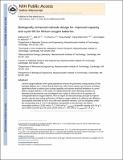Biologically enhanced cathode design for improved capacity and cycle life for lithium-oxygen batteries
Author(s)
Oh, Dahyun; Qi, Jifa; Lu, Yi-Chun; Zhang, Yong; Shao-Horn, Yang; Belcher, Angela M; ... Show more Show less
DownloadBelcher_Biologically enhanced.pdf (1.714Mb)
PUBLISHER_POLICY
Publisher Policy
Article is made available in accordance with the publisher's policy and may be subject to US copyright law. Please refer to the publisher's site for terms of use.
Terms of use
Metadata
Show full item recordAbstract
Lithium-oxygen batteries have a great potential to enhance the gravimetric energy density of fully packaged batteries by two to three times that of lithium ion cells. Recent studies have focused on finding stable electrolytes to address poor cycling capability and improve practical limitations of current lithium-oxygen batteries. In this study, the catalyst electrode, where discharge products are deposited and decomposed, was investigated as it has a critical role in the operation of rechargeable lithium-oxygen batteries. Here we report the electrode design principle to improve specific capacity and cycling performance of lithium-oxygen batteries by utilizing high-efficiency nanocatalysts assembled by M13 virus with earth-abundant elements such as manganese oxides. By incorporating only 3–5 wt% of palladium nanoparticles in the electrode, this hybrid nanocatalyst achieves 13,350 mAh g[superscript −1][subscript c] (7,340 mAh g[superscript −1][subscript c+catalyst]) of specific capacity at 0.4 A g[superscript −1][subscript c] and a stable cycle life up to 50 cycles (4,000 mAh g[superscript −1][subscript c], 400 mAh g[superscript −1][subscript c+catalyst]) at 1 A g[superscript −1][subscript c].
Date issued
2013-11Department
Massachusetts Institute of Technology. Center for Materials Science and Engineering; Massachusetts Institute of Technology. Department of Biological Engineering; Massachusetts Institute of Technology. Department of Materials Science and Engineering; Massachusetts Institute of Technology. Department of Mechanical Engineering; Massachusetts Institute of Technology. Electrochemical Energy Laboratory; Koch Institute for Integrative Cancer Research at MITJournal
Nature Communications
Publisher
Nature Publishing Group
Citation
Oh, Dahyun, Jifa Qi, Yi-Chun Lu, Yong Zhang, Yang Shao-Horn, and Angela M. Belcher. “Biologically Enhanced Cathode Design for Improved Capacity and Cycle Life for Lithium-Oxygen Batteries.” Nature Communications 4 (November 13, 2013).
Version: Author's final manuscript
ISSN
2041-1723